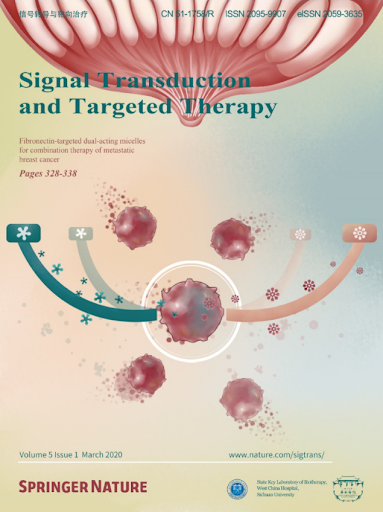Single-cell RNA-seq reveals cell type-specific molecular and genetic associations with primary open-angle glaucoma.
IF 52.7
1区 医学
Q1 BIOCHEMISTRY & MOLECULAR BIOLOGY
引用次数: 0
Abstract
Primary open-angle glaucoma (POAG), a leading cause of irreversible blindness, involves complex neurodegeneration in which the contribution of systemic immunity remains enigmatic. Here, we dissect the circulating immune landscape in POAG patients via high-resolution single-cell RNA sequencing of ~1.4 million peripheral blood mononuclear cells (PBMCs) from 110 patients and 110 controls of Chinese ancestry. We revealed significant immune remodeling in POAG, characterized by increased CD4+ T lymphocytes and myeloid cells and impaired cytolytic potential, as evidenced by reduced cell proportions of terminally differentiated CD8+ GZMK+ T cells and NK cells. Transcriptomic analysis revealed a sophisticated dual transcriptional landscape in which both proinflammatory and neuroprotective signaling pathways coexist across multiple immune cell lineages. While TNF and IFNG pathway genes were broadly downregulated, specific inflammatory activation components and neuroprotective genes were upregulated in distinct cell populations, suggesting that POAG represents a complex immunometabolic syndrome characterized by a dysregulated balance between inflammatory and neuroprotective signaling. Cell type-specific eQTL mapping and SMR analysis revealed that POAG genetic risk loci exert their effects through immune gene regulation in specific PBMC subsets. Functional validation using Ifng-/- and Tnf+/- mice in an LPS/NMDA-induced retinal injury model, which mirrored the immune alterations observed in human POAG, demonstrated that genetic deficiency in these pathways markedly exacerbated retinal ganglion cell loss and visual pathway deficits. Our study establishes a crucial link between systemic immune dysregulation-specifically the disrupted balance between inflammatory and neuroprotective signaling-and retinal health, highlighting the importance of restoring this balance for future POAG therapeutic strategies.单细胞RNA-seq揭示了原发性开角型青光眼的细胞类型特异性分子和遗传关联。
原发性开角型青光眼(POAG)是不可逆失明的主要原因,涉及复杂的神经变性,其中全身免疫的作用仍然是谜。在这里,我们通过高分辨率单细胞RNA测序分析了来自110名中国血统患者和110名对照的约140万外周血单个核细胞(PBMCs),剖析了POAG患者的循环免疫景观。我们发现POAG中存在显著的免疫重塑,其特征是CD4+ T淋巴细胞和骨髓细胞增加,细胞溶解电位受损,最终分化的CD8+ GZMK+ T细胞和NK细胞的细胞比例减少。转录组学分析揭示了一个复杂的双转录景观,其中促炎和神经保护信号通路共存于多个免疫细胞系。虽然TNF和IFNG通路基因普遍下调,但特定的炎症激活成分和神经保护基因在不同的细胞群中上调,这表明POAG代表了一种复杂的免疫代谢综合征,其特征是炎症和神经保护信号之间的失衡。细胞类型特异性eQTL定位和SMR分析表明,POAG遗传风险位点通过免疫基因调控在特定PBMC亚群中发挥作用。Ifng-/-和Tnf+/-小鼠在LPS/ nmda诱导的视网膜损伤模型中的功能验证,反映了在人类POAG中观察到的免疫改变,表明这些通路的遗传缺陷显著加剧了视网膜神经节细胞损失和视觉通路缺陷。我们的研究建立了系统性免疫失调(特别是炎症和神经保护信号之间的平衡被破坏)与视网膜健康之间的关键联系,强调了恢复这种平衡对未来POAG治疗策略的重要性。
本文章由计算机程序翻译,如有差异,请以英文原文为准。
求助全文
约1分钟内获得全文
求助全文
来源期刊

Signal Transduction and Targeted Therapy
Biochemistry, Genetics and Molecular Biology-Genetics
CiteScore
44.50
自引率
1.50%
发文量
384
审稿时长
5 weeks
期刊介绍:
Signal Transduction and Targeted Therapy is an open access journal that focuses on timely publication of cutting-edge discoveries and advancements in basic science and clinical research related to signal transduction and targeted therapy.
Scope: The journal covers research on major human diseases, including, but not limited to:
Cancer,Cardiovascular diseases,Autoimmune diseases,Nervous system diseases.
 求助内容:
求助内容: 应助结果提醒方式:
应助结果提醒方式:


